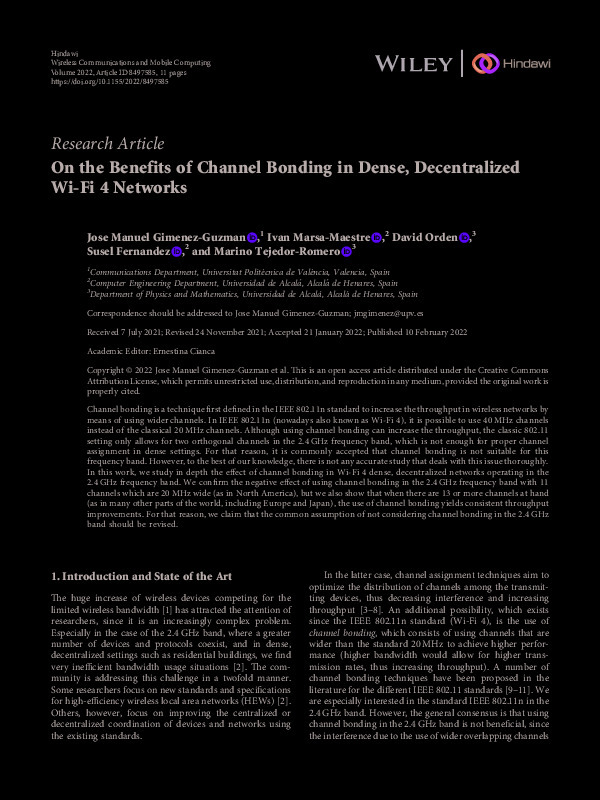JavaScript is disabled for your browser. Some features of this site may not work without it.
Buscar en RiuNet
Listar
Mi cuenta
Estadísticas
Ayuda RiuNet
Admin. UPV
On the Benefits of Channel Bonding in Dense, Decentralized Wi-Fi 4 Networks
Mostrar el registro sencillo del ítem
Ficheros en el ítem
| dc.contributor.author | Gimenez-Guzman, Jose Manuel
|
es_ES |
| dc.contributor.author | Marsa-Maestre,Ivan
|
es_ES |
| dc.contributor.author | Orden, David
|
es_ES |
| dc.contributor.author | Fernandez, Susel
|
es_ES |
| dc.contributor.author | Tejedor-Romero, Marino
|
es_ES |
| dc.date.accessioned | 2023-12-05T19:02:59Z | |
| dc.date.available | 2023-12-05T19:02:59Z | |
| dc.date.issued | 2022-02-10 | es_ES |
| dc.identifier.issn | 1530-8669 | es_ES |
| dc.identifier.uri | http://hdl.handle.net/10251/200513 | |
| dc.description | This is the peer reviewed version of the following article: Gimenez-Guzman, J. M., Marsa-Maestre, I., Orden, D., Fernandez, S., & Tejedor-Romero, M. (2022). On the benefits of channel bonding in dense, decentralized Wi-Fi 4 networks. Wireless Communications and Mobile Computing, 2022, which has been published in final form at https://doi.org/10.1155/2022/8497585. This article may be used for non-commercial purposes in accordance with Wiley Terms and Conditions for Self-Archiving". | es_ES |
| dc.description.abstract | [EN] Channel bonding is a technique first defined in the IEEE 802.11n standard to increase the throughput in wireless networks by means of using wider channels. In IEEE 802.11n (nowadays also known as Wi-Fi 4), it is possible to use 40 MHz channels instead of the classical 20 MHz channels. Although using channel bonding can increase the throughput, the classic 802.11 setting only allows for two orthogonal channels in the 2.4 GHz frequency band, which is not enough for proper channel assignment in dense settings. For that reason, it is commonly accepted that channel bonding is not suitable for this frequency band. However, to the best of our knowledge, there is not any accurate study that deals with this issue thoroughly. In this work, we study in depth the effect of channel bonding in Wi-Fi 4 dense, decentralized networks operating in the 2.4 GHz frequency band. We confirm the negative effect of using channel bonding in the 2.4 GHz frequency band with 11 channels which are 20 MHz wide (as in North America), but we also show that when there are 13 or more channels at hand (as in many other parts of the world, including Europe and Japan), the use of channel bonding yields consistent throughput improvements. For that reason, we claim that the common assumption of not considering channel bonding in the 2.4 GHz band should be revised. | es_ES |
| dc.description.sponsorship | Jose Manuel Gimenez-Guzman, Ivan Marsa-Maestre, David Orden, and Susel Fernandez were partially funded by Project SBPLY/19/180 501/000171 of the Junta de Comunidades de Castilla-La Mancha and FEDER and by Project UCeNet (CM/JIN/2019-031) of the Comunidad de Madrid and University of Alcala. Jose Manuel Gimenez-Guzman, Ivan Marsa-Maestre, and Susel Fernandez were also funded by Project PID2019-104855RB-I00/AEI/10.130 39/501 100 011 033 of the Spanish Ministry of Science and Innovation. David Orden was also partially supported by Project PID2019-104129GB-I00/AEI/10.130 39/501 100 011 033 of the Spanish Ministry of Science and Innovation and by H2020-MSCA-RISE Project 734922 - CONNECT. Marino Tejedor-Romero was funded by a predoctoral contract from University of Alcala. | es_ES |
| dc.language | Inglés | es_ES |
| dc.publisher | John Wiley & Sons | es_ES |
| dc.relation.ispartof | Wireless Communications and Mobile Computing | es_ES |
| dc.rights | Reconocimiento (by) | es_ES |
| dc.subject.classification | INGENIERÍA TELEMÁTICA | es_ES |
| dc.title | On the Benefits of Channel Bonding in Dense, Decentralized Wi-Fi 4 Networks | es_ES |
| dc.type | Artículo | es_ES |
| dc.identifier.doi | 10.1155/2022/8497585 | es_ES |
| dc.relation.projectID | info:eu-repo/grantAgreement/AEI/Plan Estatal de Investigación Científica y Técnica y de Innovación 2017-2020/PID2019-104129GB-I00/ES/TEORIA Y APLICACIONES DE CONFIGURACIONES DE PUNTOS Y REDES/ | es_ES |
| dc.relation.projectID | info:eu-repo/grantAgreement/CAM//CM%2FJIN%2F2019-031//UCeNet/ | es_ES |
| dc.relation.projectID | info:eu-repo/grantAgreement/AEI/Plan Estatal de Investigación Científica y Técnica y de Innovación 2017-2020/PID2019-104855RB-I00/ES/PLATAFORMA DE RESILIENCIA BASADA EN CLOUD PARA INFRAESTRUCTURAS DE TI SANITARIAS/ | es_ES |
| dc.relation.projectID | info:eu-repo/grantAgreement/ERC//734922/ | es_ES |
| dc.relation.projectID | info:eu-repo/grantAgreement/EC/H2020/734922/EU | es_ES |
| dc.relation.projectID | info:eu-repo/grantAgreement/JCCM//SBPLY%2F19%2F180501%2F000171/ | es_ES |
| dc.relation.projectID | info:eu-repo/grantAgreement/MICINN//PID2019-104855RB-I00//Plataforma de resiliencia basada en cloud para infraestructuras TI sanitarias/ | es_ES |
| dc.relation.projectID | info:eu-repo/grantAgreement/MICINN//PID2019-104129GB/ | es_ES |
| dc.rights.accessRights | Abierto | es_ES |
| dc.contributor.affiliation | Universitat Politècnica de València. Escuela Técnica Superior de Ingenieros de Telecomunicación - Escola Tècnica Superior d'Enginyers de Telecomunicació | es_ES |
| dc.description.bibliographicCitation | Gimenez-Guzman, JM.; Marsa-Maestre, I.; Orden, D.; Fernandez, S.; Tejedor-Romero, M. (2022). On the Benefits of Channel Bonding in Dense, Decentralized Wi-Fi 4 Networks. Wireless Communications and Mobile Computing. 2022:1-11. https://doi.org/10.1155/2022/8497585 | es_ES |
| dc.description.accrualMethod | S | es_ES |
| dc.relation.publisherversion | https://doi.org/10.1155/2022/8497585 | es_ES |
| dc.description.upvformatpinicio | 1 | es_ES |
| dc.description.upvformatpfin | 11 | es_ES |
| dc.type.version | info:eu-repo/semantics/publishedVersion | es_ES |
| dc.description.volume | 2022 | es_ES |
| dc.relation.pasarela | S\455314 | es_ES |
| dc.contributor.funder | Comunidad de Madrid | es_ES |
| dc.contributor.funder | Universidad de Alcalá | es_ES |
| dc.contributor.funder | European Research Council | es_ES |
| dc.contributor.funder | European Regional Development Fund | es_ES |
| dc.contributor.funder | Ministerio de Ciencia e Innovación | es_ES |
| dc.contributor.funder | Junta de Comunidades de Castilla-La Mancha | es_ES |








